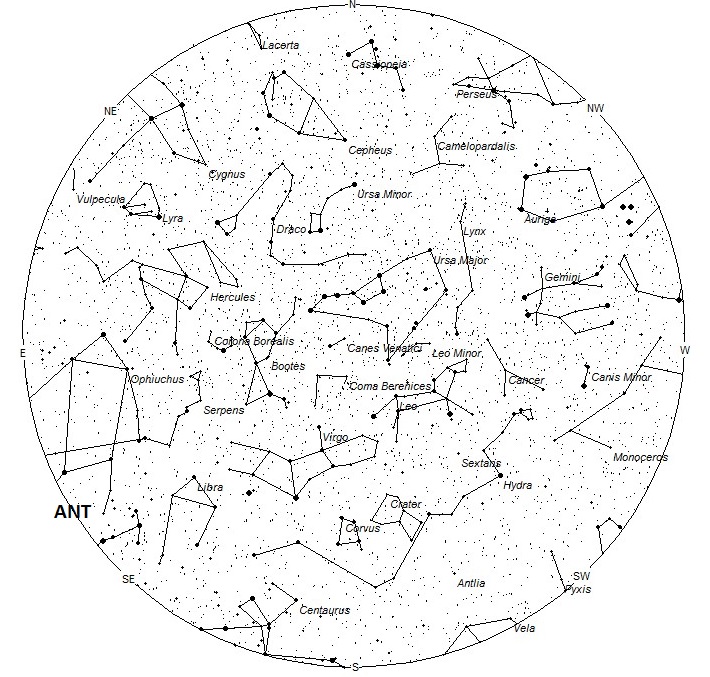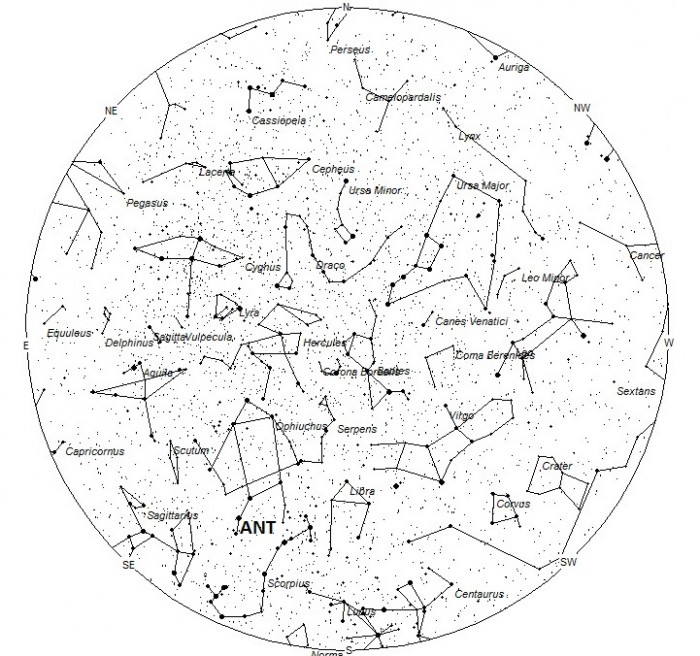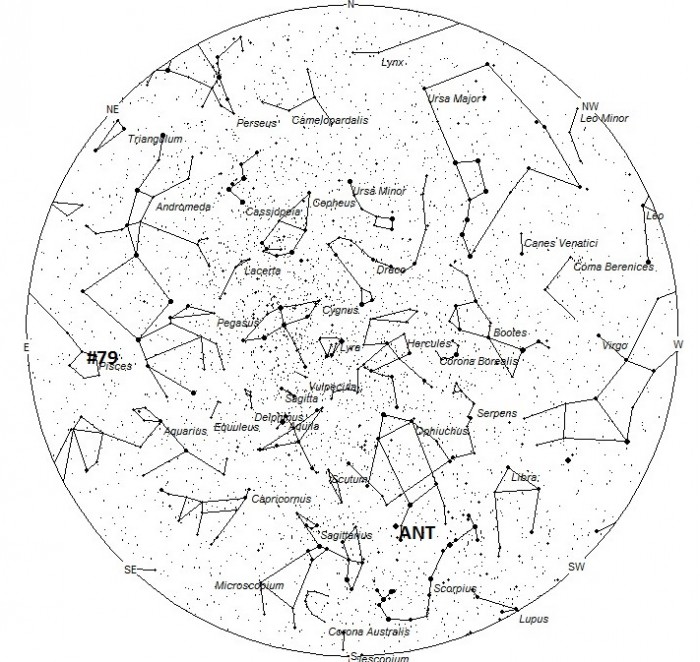During this period the moon reaches its full phase on Saturday the 25th. At this time the moon will rise shortly after dusk and set shortly before dawn as seen from mid-northern latitudes. With the full moon in the sky nearly all night, this weekend will be a poor time to try and view meteor activity. Circumstances improve slightly as the moon wanes and rises later with each passing night. Unfortunately the moon will still be above the horizon during the more active morning hours during this entire period. The estimated total hourly meteor rates for evening observers this week is near two as seen from the northern hemisphere and three as seen from south of the equator. For morning observers the estimated total hourly rates should be near three as seen from the northern hemisphere and six as seen from the southern hemisphere. The actual rates will also depend on factors such as personal light and motion perception, local weather conditions, alertness and experience in watching meteor activity. Rates are reduced during this period due to moonlight.
The radiant (the area of the sky where meteors appear to shoot from) positions and rates listed below are exact for Saturday night/Sunday morning May 25/26. These positions do not change greatly day to day so the listed coordinates may be used during this entire period. Most star atlases (available at science stores and planetariums) will provide maps with grid lines of the celestial coordinates so that you may find out exactly where these positions are located in the sky. A planisphere or computer planetarium program is also useful in showing the sky at any time of night on any date of the year. Activity from each radiant is best seen when it is positioned highest in the sky, either due north or south along the meridian, depending on your latitude. It must be remembered that meteor activity is rarely seen at the radiant position. Rather they shoot outwards from the radiant so it is best to center your field of view so that the radiant lies at the edge and not the center. Viewing there will allow you to easily trace the path of each meteor back to the radiant (if it is a shower member) or in another direction if it is a sporadic. Meteor activity is not seen from radiants that are located below the horizon. The positions below are listed in a west to east manner in order of right ascension (celestial longitude). The positions listed first are located further west therefore are accessible earlier in the night while those listed further down the list rise later in the night.
The following showers are expected to be active this week. Details on each shower will be continued next week when observing conditions improve.
| SHOWER | DATE OF MAXIMUM ACTIVITY | CELESTIAL POSITION | ENTRY VELOCITY | CULMINATION | HOURLY RATE | CLASS |
| RA (RA in Deg.) DEC | Km/Sec | Local Daylight Time | North-South | |||
| Anthelions (ANT) | – | 17:08 (257) -23 | 30 | 02:00 | 1 – 2 | II |
| IMO #79 | May 26 | 23:29 (352) +07 | 69 | 08:00 | <1 – <1 | IV |
 American Meteor Society
American Meteor Society



I saw something in the western part of the sky it was the brightest one iv ever Seen. It was when I was looking at the conjunction tonight
Heading west from NYC to Bethlehem. Saw a very large fireball. Blue to green to bright white and then gone! So cool. Around 12:30 a.m. Or so
Tonight I saw the most beautiful and amazing thing I’ve every seen in the sky. It was HUGE and seemed to move a little slower than the few shooting stars I’ve seen in my life. It had a blue hue to it and the tail was really long. My husband and two friends were over and I feel so bad for them that they missed it, because I think it will stick with me for the rest of my life. It was amazing. It really was enormous in size. I am sure I will never see anything like it again in my life! Yeah! I feel so lucky. A luna moth landed on my sweater earlier in the night, during the full moon. It was an odd night!
Hi….I thought i was going crazy last night!!! Around 10pm on Long Island, NY…I looked up to see the little dipper…I saw several slow moving “fireballs” coming directly out of the “pot” of the LD’r. The first one was mich brighter then the other 2 a saw….but they were moving SO SLOW!! Definately was NOT a plane…because they all appeared and disappeared around the same spot….but each one lasted for at least 10 seconds! I also saw several meteors streak across the sky at that same time period…but they were going perpendicular to these slower moving objects! I wish I could find some actual reports about what we saw.
“It had a blue hue to it and the tail was really long.” I think we saw the same thing!! So awesome!
What the hell was going on with NOAA radar,,, showed meteors coming through the sky when tornados were in OK today on the 31st on May 2013??? strange???
We saw it briefly in NH, The trees blocked our view. Screaming across the night sky, but appeared slower than a shooting star (same thing). They say it might be a chunk off of Pan- STARR the comet.
Keith, Peg, and All,
This fireball is not associated with Comet Pan-Starrs. This comet never came close enough to the Earth to produce any meteoric activity.
Robert Lunsford
American Meteor Society
On June 1st at approximately 9:50pm Eastern TIme, I was driving home when I saw what appeared to me as something on fire low in the north sky. By the time that I was able stop my car and get out to photograph the object it appeared like a very small sun. There was no tail and it was not “streaking” across the sky, in fact it appeared almost stationary when I first began photographing it. I then realized that it was getting smaller as if it was moving away from me. Eventually it disappeared. From the time that I originally noticed the “fire in the sky” until it finally disappeared was at least one minut or slightly longer.